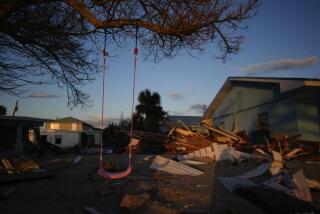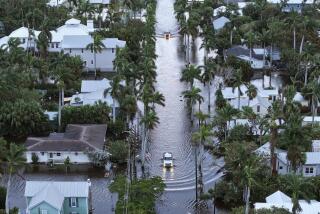Desperate hours
HOW LONG CAN A STRANDED FAMILY squat on the peak of their roof, without food or safe water, waiting for rescue? How can virtually all of a city that no longer functions be evacuated? How can the ugly stew of contaminated water that has flooded parts of New Orleans to the rooflines be poured back into Lake Pontchartrain, and how long will it take?
These are the questions that spur desperate rescuers and government officials in the wake of Hurricane Katrina. Dazed residents of New Orleans looked like the cast of “Day of the Dead” as they stumbled through knee-high water or worse, looking for help or direction from anyone. And the dead are far from counted in Louisiana and Mississippi.
The magnitude of the suffering has moved Americans everywhere. Fire departments from all over the country, including Los Angeles, have rushed to provide expert and self-sufficient rescue crews. Red Cross teams and medical assistance are rushing in. DuPont, owner of chemical plants in Louisiana, has offered $1 million in cash, and other donations are pouring into relief agencies (see the list on page A19 to donate). Property owners from afar have listed free or dirt-cheap lodging to victims through the classifieds at craigslist.org: “2br apt. Austin Texas, 1.5 months, for disaster victims.” The site’s lost-and-found section, instead of pets or family heirlooms, now features pleas for information on missing or dispersed friends and families as well as offers of help.
Less uplifting was the widespread looting and some violence reported in New Orleans and elsewhere. “It’s Baghdad,” said one angry, stranded tourist watching a French Quarter rampage. There were unconfirmed reports of refugees trying to carjack their way to safety.
The disaster might have been even worse had the hurricane not ebbed from the strongest category at landfall. Still, the subdued relief that Katrina hadn’t hit New Orleans dead-on came too soon. Levee breaks on Lake Pontchartrain did what the hurricane hadn’t: ruined much of the city. Parts of Mississippi, mainly Gulfport and Biloxi, and Alabama and Florida also suffered severe damage and dangerous contamination. But New Orleans seemed hopeless by comparison.
Hard questions linger in the background: about the levee system that was the only thing between a city below sea level and disaster; about scientists starting to say that the recent severity of hurricanes is linked to global warming; about economic losses estimated in the tens of billions, and about oil prices after the shutdown of Gulf of Mexico platforms.
For now, though, the chief concern is grasping the magnitude of damage to lives and communities, and the perseverance that will be needed to rebuild them. The suffering we now see on television will not fade in reality when it is displaced from our screens.
More to Read
Sign up for Essential California
The most important California stories and recommendations in your inbox every morning.
You may occasionally receive promotional content from the Los Angeles Times.










